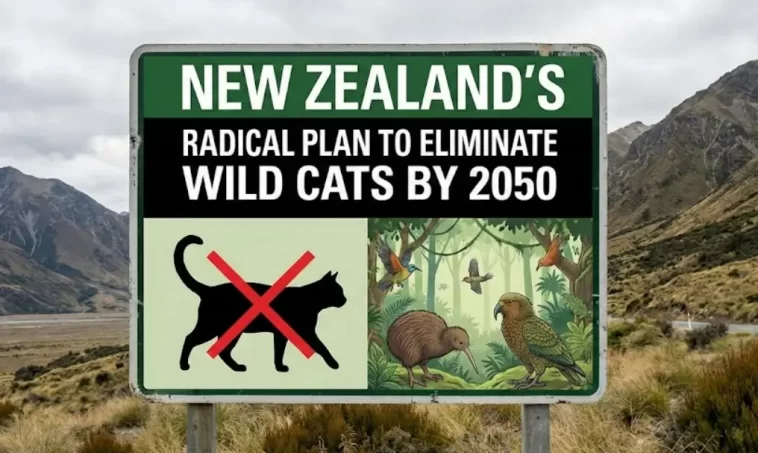New Zealand eliminate wild cats — New Zealand has announced one of the most dramatic wildlife management decisions in its modern conservation history. The government has formally revealed a new and highly controversial national strategy that aims to completely eliminate the country’s wild cat population by 2050, a move officials say is essential to protect the nation’s collapsing biodiversity.
This landmark decision instantly sparked a wave of shock, criticism, and support, placing New Zealand once more at the center of an intense global debate over environmental ethics, invasive species control, and humane wildlife management.
A Radical Expansion of the Predator-Free 2050 Program
The new plan was announced by Conservation Minister Tama Potaka, who confirmed that wild cats have now been officially added to the long-running “Predator-Free 2050” initiative. Until now, the program targeted species such as stoats, rats, weasels, and possums—animals widely recognized as threats to New Zealand’s fragile ecosystems.
Including wild cats marks the first major expansion of the program since its launch in 2016, and represents a fundamental shift in how the nation approaches invasive predators.
Potaka described wild cats as “cold-blooded killers”, placing them in the same destructive category as other invasive mammals responsible for pushing several native species toward extinction.
“If we want to protect our natural heritage and restore biodiversity, we must remove these predators,” Potaka said in an interview with Radio New Zealand.
Coordinated Extermination Programs on the Way
While wild cats have been selectively culled in specific regions for years, authorities now plan to implement coordinated, nationwide extermination programs beginning in 2026.
A detailed roadmap—outlining approved methods, ethical guidelines, and implementation stages—is scheduled to be released in March 2026.
Environmental officials say the shift from localized efforts to national-scale eradication is necessary because regional control measures have not been enough to prevent native species from declining.
An Estimated 2.5 Million Wild Cats Roam the Country
New Zealand is home to more than 2.5 million wild cats, primarily inhabiting remote forests, grasslands, and offshore islands.
These cats, which can grow to one meter in length with their tails and weigh up to seven kilograms, have been linked to severe ecological damage, including:
- The near-extinction of the Pukunui/Southern dotterel, a critically endangered bird native to Rakiura Stewart Island.
- The death of endangered bats around Mount Ruapehu, one of the last surviving native mammal species in the country.
- A steep decline in small bird populations, lizards, and insects.
Predation by cats—both feral and free-roaming domestic ones—has long been considered one of the leading human-induced threats to New Zealand’s unique wildlife.
A Decision Years in the Making
Although the 2050 eradication plan is new, public debate surrounding wild cats is not. In 2013, environmentalist Gareth Morgan launched the controversial “Cats to Go” campaign, arguing that domestic and wild cats were destroying biodiversity.
His proposals included reducing outdoor cat roaming and even phasing out cat ownership in certain areas. The campaign was met with fierce backlash from cat owners, animal rights groups, and even some politicians.
One of the darkest moments came when a children’s event promoting wild cat hunting competitions emerged, sparking national outrage and accusations of promoting cruelty.
Yet despite these tensions, the government says that 90% of public feedback received on recent biodiversity strategy drafts supported the need for stronger wild cat controls.
Domestic Cats Not Included — But Still Part of the Debate
The government clarified that domestic cats are not part of the eradication plan. However, officials emphasized that free-roaming pets continue to pose a serious ecological risk.
New Zealand has one of the highest cat ownership rates in the world, and regulations vary drastically by region. Animal welfare groups and conservation organizations have long argued for:
- Mandatory microchipping
- Mandatory desexing (spaying/neutering)
- Strict limits on outdoor roaming
- A national cat ownership registry
The National Cat Management Group, which includes animal rights organizations and conservation trusts, is actively lobbying for a unified national law. The group recently launched the slogan “Every Cat in a Lap”, encouraging owners to keep their pets indoors.
Animal Rights Advocates Voice Strong Objections
Not surprisingly, the new eradication plan has drawn criticism from animal rights groups across the country.
Christine Sumner, Science Advisor at SPCA New Zealand, acknowledged the ecological damage caused by wild cats but expressed concern over what she called a “kill-first model” of wildlife management.
“We are not comfortable with lethal control being the primary tool. There must be investment in more humane alternatives,” she said.
These alternatives may include fertility control technologies, relocation programs, or non-lethal trapping systems. However, conservation officials argue that such methods are not yet scalable enough to protect endangered species.
Organizations are urging the government to allocate funding for research into more ethical population management solutions.
A Divided Nation Facing a Difficult Choice
New Zealand’s environmental identity has long been shaped by a fierce determination to protect its native species—many of which exist nowhere else on Earth. But achieving this goal often requires confronting painful ethical questions.
Gareth Morgan maintains that failing to target wild cats earlier was a mistake:
“It was a major oversight not to include wild cats from the start. If we want real results, we must embrace policy changes and take decisive action.”
For some New Zealanders, the eradication plan represents a necessary step in healing the land. For others, it is a grim and unsettling reminder of how far humans will go to correct past ecological mistakes.
As the country prepares for the next phase of its Predator-Free 2050 strategy, the world will be watching closely — not only to see whether New Zealand can achieve the impossible, but also to understand the ethical, ecological, and cultural consequences of this bold plan.

